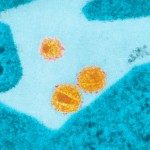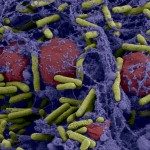Link to Pubmed [PMID] – 23696662
Proc. Natl. Acad. Sci. U.S.A. 2013 Jun;110(23):9475-80
CC chemokine receptor 5 (CCR5) is a receptor for chemokines and the coreceptor for R5 HIV-1 entry into CD4(+) T lymphocytes. Chemokines exert anti-HIV-1 activity in vitro, both by displacing the viral envelope glycoprotein gp120 from binding to CCR5 and by promoting CCR5 endocytosis, suggesting that they play a protective role in HIV infection. However, we showed here that different CCR5 conformations at the cell surface are differentially engaged by chemokines and gp120, making chemokines weaker inhibitors of HIV infection than would be expected from their binding affinity constants for CCR5. These distinct CCR5 conformations rely on CCR5 coupling to nucleotide-free G proteins ((NF)G proteins). Whereas native CCR5 chemokines bind with subnanomolar affinity to (NF)G protein-coupled CCR5, gp120/HIV-1 does not discriminate between (NF)G protein-coupled and uncoupled CCR5. Interestingly, the antiviral activity of chemokines is G protein independent, suggesting that “low-chemokine affinity” (NF)G protein-uncoupled conformations of CCR5 represent a portal for viral entry. Furthermore, chemokines are weak inducers of CCR5 endocytosis, as is revealed by EC50 values for chemokine-mediated endocytosis reflecting their low-affinity constant value for (NF)G protein-uncoupled CCR5. Abolishing CCR5 interaction with (NF)G proteins eliminates high-affinity binding of CCR5 chemokines but preserves receptor endocytosis, indicating that chemokines preferentially endocytose low-affinity receptors. Finally, we evidenced that chemokine analogs achieve highly potent HIV-1 inhibition due to high-affinity interactions with internalizing and/or gp120-binding receptors. These data are consistent with HIV-1 evading chemokine inhibition by exploiting CCR5 conformational heterogeneity, shed light into the inhibitory mechanisms of anti-HIV-1 chemokine analogs, and provide insights for the development of unique anti-HIV molecules.

